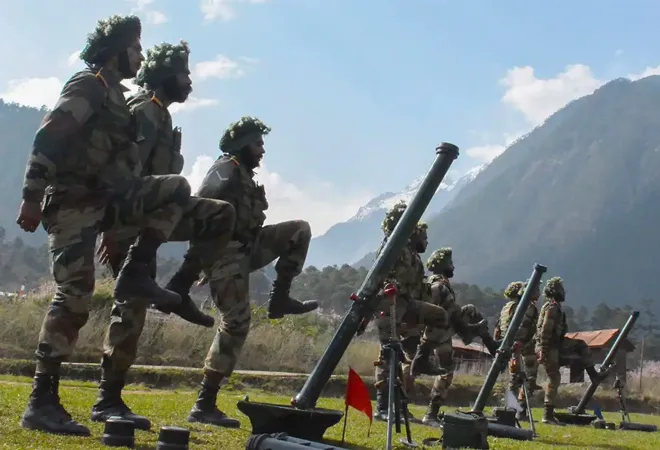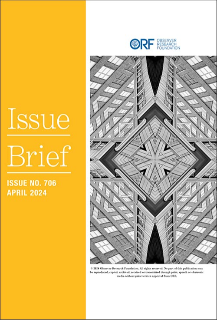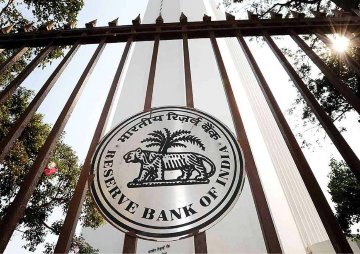
On the night of August 29-30, the Indian Army (IA) and the People’s Liberation Army (PLA) troops clashed again on the South Bank of the Pangong Tso lake, an area not otherwise in contestation during the ongoing crisis, underlining how tense the ongoing stand-off has become along the Line of Actual Control (LAC). The Indian army did thwart the PLA’s designs by managing to occupy the dominating heights, thereby positioning themselves at an advantageous position. As claims and counterclaims continue, this incident underscores the likely future of the LAC – a heavily militarized frontier with frequent clashes between the two militaries. Until the latest altercation Chinese and Indian forces were locked in a stalemate since the mid-July clash that resulted in the death of 20 Indian soldiers following the PLA’s seizure of territory in Ladakh in early May. Consequently, the LAC is likely to continue to remain “hot” with military activity in the form of occasional violent clashes mirroring the Line of Control (LoC) which is the de facto boundary that divides Kashmir between India and Pakistan. This is the “new normal” that both India and China will now have to contend with. A Brigade level flag meeting is believed to have occurred since the latest clash albeit inconclusively reflecting the level of uncertainty, volatility and intractability that has gripped the two sides since the outbreak of the crisis in April-May. Despite five rounds of talks between military commanders of both sides, the crisis shows no signs of abating.
It is very possible that skirmishes, sniper attacks and ambushes are going to be the pervasive feature of cross LAC engagements as we witness between Indian and Pakistan in Kashmir. The Indian Army will need to prepare accordingly for these contingencies to both thwart and respond promptly to PLA transgressions and violations. Beyond these measures, the defence establishment will have to brace for a protracted stand-off with substantial force deployments as the PLA has done.
Since May, China has progressively deployed large forces to consolidate its presence on the territory patrolled and claimed by India especially in Ladakh. Chinese deployments have since included heavy artillery, tanks, heavy machine guns, and aircraft on bases in the Tibetan Autonomous Region (TAR). Coinciding with the August 29-30 clash China in a minatory move has deployed Surface to Air Missiles (SAMs) at a lake located at Mount Kailash and Mansarover or better known as Kailash-Mansarover. In addition, the missile base also hosts the Dong-Feng-21 (DF-21) ballistic missile with a range of 2200 km range and sits at the mouth of the transboundary rivers that includes the Brahmaputra, Sutlej, Indus and Karnali, which is a major tributary of the Ganges presenting a particularly dire threat to India. More significantly, the DF-21 can strike urban targets deep inside India. The DF-21 very critically provides a cover for executing a conventional attack. Consequently, India has to consider the deployment of countervailing capabilities to inflict retribution.
Although a pure punishment-based strategy even against low-level Chinese aggression by India may lack credibility, India will need to counterbalance it with the lack of initiative in the event it were to pursue a purely defensive strategy. Indeed in 2013, Indian forces did enforce a limited punishment-based strategy by pushing their own forces aross the LAC. Denial generally must be the focus of India’s military strategy particularly in limited conflict fought over a short duration. While absorbing some initial loss, India needs to be prepared for a conflict of slightly greater duration that remains localised by building greater levels of resilience. For instance, the Indian Army and Air Force must use civilian airports effectively. Concealment, deception and mobility will also complicate and help with limiting the impact of a military attack from China. Post-attack recovery and response is also crucial, in that Indian air assets may need wide dispersion and static targets such as airfields that are damaged will need to be reconstituted quickly.
The Chinese are more likely to nibble away Indian territory, which is their most effective option as they have already demonstrated in Ladakh, which Indian forces will have to respond to in kind whereever Indian forces enjoy tactical advantages. New Delhi for its part will have to consider asymmetric options in response to the menacing military moves made by China. If the LAC is going to parallel the violent military activity that characterizes the India-Pakistan relations, it is likely that debate will soon move towards India considering the development and deployment of tactical nuclear weapons to deter an attack. An asymmetric retaliatory strategy is geared to punish the adversary and hence offence dominant. India needs to start exploring the possibility of deploying and signalling clearly in advance that New Delhi is ready and willing to escalate. This is neither an easy choice for India nor a cost free one but after decades of ignoring the conventional challenge from China and not building up its strength commensurate to the challenge, the options are getting narrower.
As India confronts a “new normal” on the LAC, India cannot rely on old strategic paradigms. Indian policymakers are making it clear that everything is on the table if China doesn’t mend its ways. While they need to make it clear to Beijing that they indeed have the resolve to escalate, they will have to factor in not only the first, but also the the fourth and fifth rung on the escalation ladder. It’s a delicate balancing act but a necessary one if India is to move beyond the sterile debate of it having no real military options vis-à-vis China on the one hand and seemingly a range of options which are never really specified.
The views expressed above belong to the author(s). ORF research and analyses now available on Telegram! Click here to access our curated content — blogs, longforms and interviews.



 On the night of August 29-30, the Indian Army (IA) and the People’s Liberation Army (PLA) troops clashed again on the South Bank of the Pangong Tso lake, an area not otherwise in contestation during the ongoing crisis, underlining how tense the ongoing stand-off has become along the Line of Actual Control (LAC). The Indian army did thwart the PLA’s designs by managing to occupy the dominating heights, thereby positioning themselves at an advantageous position. As claims and counterclaims continue, this incident underscores the likely future of the LAC – a heavily militarized frontier with frequent clashes between the two militaries. Until the latest altercation Chinese and Indian forces were locked in a stalemate since the mid-July clash that resulted in the death of 20 Indian soldiers following the PLA’s seizure of territory in Ladakh in early May. Consequently, the LAC is likely to continue to remain “hot” with military activity in the form of occasional violent clashes mirroring the Line of Control (LoC) which is the de facto boundary that divides Kashmir between India and Pakistan. This is the “new normal” that both India and China will now have to contend with. A Brigade level flag meeting is believed to have occurred since the latest clash albeit inconclusively reflecting the level of uncertainty, volatility and intractability that has gripped the two sides since the outbreak of the crisis in April-May. Despite five rounds of talks between military commanders of both sides, the crisis shows no signs of abating.
It is very possible that skirmishes, sniper attacks and ambushes are going to be the pervasive feature of cross LAC engagements as we witness between Indian and Pakistan in Kashmir. The Indian Army will need to prepare accordingly for these contingencies to both thwart and respond promptly to PLA transgressions and violations. Beyond these measures, the defence establishment will have to brace for a protracted stand-off with substantial force deployments as the PLA has done.
Since May, China has progressively deployed large forces to consolidate its presence on the territory patrolled and claimed by India especially in Ladakh. Chinese deployments have since included heavy artillery, tanks, heavy machine guns, and aircraft on bases in the Tibetan Autonomous Region (TAR). Coinciding with the August 29-30 clash China in a minatory move has deployed Surface to Air Missiles (SAMs) at a lake located at Mount Kailash and Mansarover or better known as Kailash-Mansarover. In addition, the missile base also hosts the Dong-Feng-21 (DF-21) ballistic missile with a range of 2200 km range and sits at the mouth of the transboundary rivers that includes the Brahmaputra, Sutlej, Indus and Karnali, which is a major tributary of the Ganges presenting a particularly dire threat to India. More significantly, the DF-21 can strike urban targets deep inside India. The DF-21 very critically provides a cover for executing a conventional attack. Consequently, India has to consider the deployment of countervailing capabilities to inflict retribution.
Although a pure punishment-based strategy even against low-level Chinese aggression by India may lack credibility, India will need to counterbalance it with the lack of initiative in the event it were to pursue a purely defensive strategy. Indeed in 2013, Indian forces did enforce a limited punishment-based strategy by pushing their own forces aross the LAC. Denial generally must be the focus of India’s military strategy particularly in limited conflict fought over a short duration. While absorbing some initial loss, India needs to be prepared for a conflict of slightly greater duration that remains localised by building greater levels of resilience. For instance, the Indian Army and Air Force must use civilian airports effectively. Concealment, deception and mobility will also complicate and help with limiting the impact of a military attack from China. Post-attack recovery and response is also crucial, in that Indian air assets may need wide dispersion and static targets such as airfields that are damaged will need to be reconstituted quickly.
The Chinese are more likely to nibble away Indian territory, which is their most effective option as they have already demonstrated in Ladakh, which Indian forces will have to respond to in kind whereever Indian forces enjoy tactical advantages. New Delhi for its part will have to consider asymmetric options in response to the menacing military moves made by China. If the LAC is going to parallel the violent military activity that characterizes the India-Pakistan relations, it is likely that debate will soon move towards India considering the development and deployment of tactical nuclear weapons to deter an attack. An asymmetric retaliatory strategy is geared to punish the adversary and hence offence dominant. India needs to start exploring the possibility of deploying and signalling clearly in advance that New Delhi is ready and willing to escalate. This is neither an easy choice for India nor a cost free one but after decades of ignoring the conventional challenge from China and not building up its strength commensurate to the challenge, the options are getting narrower.
As India confronts a “new normal” on the LAC, India cannot rely on old strategic paradigms. Indian policymakers are making it clear that everything is on the table if China doesn’t mend its ways. While they need to make it clear to Beijing that they indeed have the resolve to escalate, they will have to factor in not only the first, but also the the fourth and fifth rung on the escalation ladder. It’s a delicate balancing act but a necessary one if India is to move beyond the sterile debate of it having no real military options vis-à-vis China on the one hand and seemingly a range of options which are never really specified.
On the night of August 29-30, the Indian Army (IA) and the People’s Liberation Army (PLA) troops clashed again on the South Bank of the Pangong Tso lake, an area not otherwise in contestation during the ongoing crisis, underlining how tense the ongoing stand-off has become along the Line of Actual Control (LAC). The Indian army did thwart the PLA’s designs by managing to occupy the dominating heights, thereby positioning themselves at an advantageous position. As claims and counterclaims continue, this incident underscores the likely future of the LAC – a heavily militarized frontier with frequent clashes between the two militaries. Until the latest altercation Chinese and Indian forces were locked in a stalemate since the mid-July clash that resulted in the death of 20 Indian soldiers following the PLA’s seizure of territory in Ladakh in early May. Consequently, the LAC is likely to continue to remain “hot” with military activity in the form of occasional violent clashes mirroring the Line of Control (LoC) which is the de facto boundary that divides Kashmir between India and Pakistan. This is the “new normal” that both India and China will now have to contend with. A Brigade level flag meeting is believed to have occurred since the latest clash albeit inconclusively reflecting the level of uncertainty, volatility and intractability that has gripped the two sides since the outbreak of the crisis in April-May. Despite five rounds of talks between military commanders of both sides, the crisis shows no signs of abating.
It is very possible that skirmishes, sniper attacks and ambushes are going to be the pervasive feature of cross LAC engagements as we witness between Indian and Pakistan in Kashmir. The Indian Army will need to prepare accordingly for these contingencies to both thwart and respond promptly to PLA transgressions and violations. Beyond these measures, the defence establishment will have to brace for a protracted stand-off with substantial force deployments as the PLA has done.
Since May, China has progressively deployed large forces to consolidate its presence on the territory patrolled and claimed by India especially in Ladakh. Chinese deployments have since included heavy artillery, tanks, heavy machine guns, and aircraft on bases in the Tibetan Autonomous Region (TAR). Coinciding with the August 29-30 clash China in a minatory move has deployed Surface to Air Missiles (SAMs) at a lake located at Mount Kailash and Mansarover or better known as Kailash-Mansarover. In addition, the missile base also hosts the Dong-Feng-21 (DF-21) ballistic missile with a range of 2200 km range and sits at the mouth of the transboundary rivers that includes the Brahmaputra, Sutlej, Indus and Karnali, which is a major tributary of the Ganges presenting a particularly dire threat to India. More significantly, the DF-21 can strike urban targets deep inside India. The DF-21 very critically provides a cover for executing a conventional attack. Consequently, India has to consider the deployment of countervailing capabilities to inflict retribution.
Although a pure punishment-based strategy even against low-level Chinese aggression by India may lack credibility, India will need to counterbalance it with the lack of initiative in the event it were to pursue a purely defensive strategy. Indeed in 2013, Indian forces did enforce a limited punishment-based strategy by pushing their own forces aross the LAC. Denial generally must be the focus of India’s military strategy particularly in limited conflict fought over a short duration. While absorbing some initial loss, India needs to be prepared for a conflict of slightly greater duration that remains localised by building greater levels of resilience. For instance, the Indian Army and Air Force must use civilian airports effectively. Concealment, deception and mobility will also complicate and help with limiting the impact of a military attack from China. Post-attack recovery and response is also crucial, in that Indian air assets may need wide dispersion and static targets such as airfields that are damaged will need to be reconstituted quickly.
The Chinese are more likely to nibble away Indian territory, which is their most effective option as they have already demonstrated in Ladakh, which Indian forces will have to respond to in kind whereever Indian forces enjoy tactical advantages. New Delhi for its part will have to consider asymmetric options in response to the menacing military moves made by China. If the LAC is going to parallel the violent military activity that characterizes the India-Pakistan relations, it is likely that debate will soon move towards India considering the development and deployment of tactical nuclear weapons to deter an attack. An asymmetric retaliatory strategy is geared to punish the adversary and hence offence dominant. India needs to start exploring the possibility of deploying and signalling clearly in advance that New Delhi is ready and willing to escalate. This is neither an easy choice for India nor a cost free one but after decades of ignoring the conventional challenge from China and not building up its strength commensurate to the challenge, the options are getting narrower.
As India confronts a “new normal” on the LAC, India cannot rely on old strategic paradigms. Indian policymakers are making it clear that everything is on the table if China doesn’t mend its ways. While they need to make it clear to Beijing that they indeed have the resolve to escalate, they will have to factor in not only the first, but also the the fourth and fifth rung on the escalation ladder. It’s a delicate balancing act but a necessary one if India is to move beyond the sterile debate of it having no real military options vis-à-vis China on the one hand and seemingly a range of options which are never really specified.
 PREV
PREV



